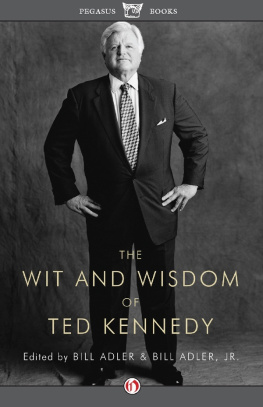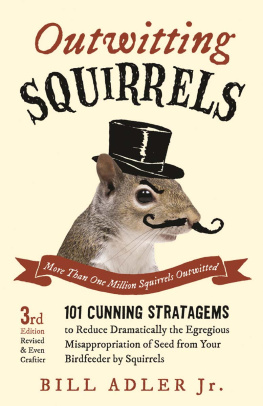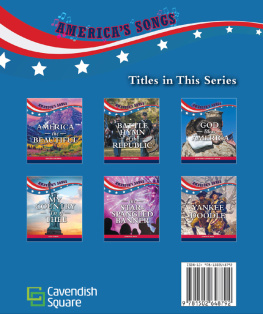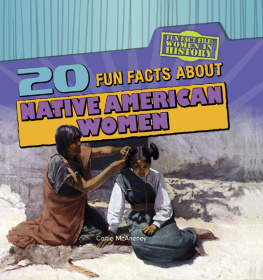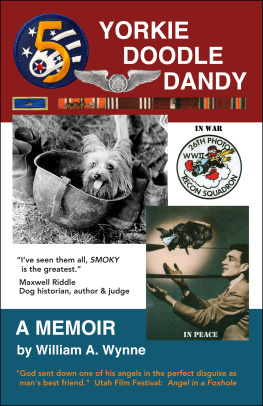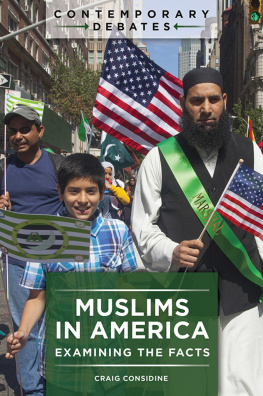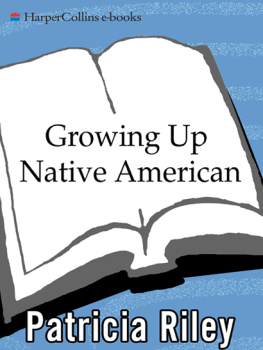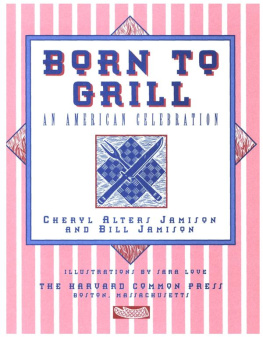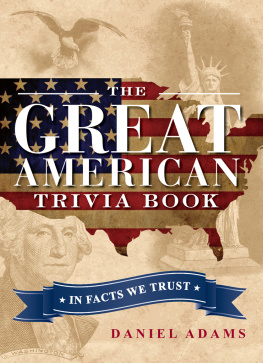Bill Adler - 500 Great Facts to Know About America
Here you can read online Bill Adler - 500 Great Facts to Know About America full text of the book (entire story) in english for free. Download pdf and epub, get meaning, cover and reviews about this ebook. year: 2011, publisher: HarperCollins, genre: Home and family. Description of the work, (preface) as well as reviews are available. Best literature library LitArk.com created for fans of good reading and offers a wide selection of genres:
Romance novel
Science fiction
Adventure
Detective
Science
History
Home and family
Prose
Art
Politics
Computer
Non-fiction
Religion
Business
Children
Humor
Choose a favorite category and find really read worthwhile books. Enjoy immersion in the world of imagination, feel the emotions of the characters or learn something new for yourself, make an fascinating discovery.

- Book:500 Great Facts to Know About America
- Author:
- Publisher:HarperCollins
- Genre:
- Year:2011
- Rating:3 / 5
- Favourites:Add to favourites
- Your mark:
- 60
- 1
- 2
- 3
- 4
- 5
500 Great Facts to Know About America: summary, description and annotation
We offer to read an annotation, description, summary or preface (depends on what the author of the book "500 Great Facts to Know About America" wrote himself). If you haven't found the necessary information about the book — write in the comments, we will try to find it.
A pro-American look at history calls for a celebration of American achievement, discussing how the pilgrims staved off starvation, facts behind the song Yankee Doodle Dandy, the mystery behind Zachary Taylors death, and more.
500 Great Facts to Know About America — read online for free the complete book (whole text) full work
Below is the text of the book, divided by pages. System saving the place of the last page read, allows you to conveniently read the book "500 Great Facts to Know About America" online for free, without having to search again every time where you left off. Put a bookmark, and you can go to the page where you finished reading at any time.
Font size:
Interval:
Bookmark:
500
GREAT FACTS
ABOUT
AMERICA
BILL ADLER
Illustrations by William Bramhall



Discovery and Exploration
. Are we there yet?
c. 1492On August 3, Christopher Columbus set sail from Palos, Spain, on the Santa Maria in search of Asia. The Pe$nTzon brothers commanded the sister ships, the Nina and the Pi$nTta. The crews had been promised a bonus for a first sighting of land and when an early-morning haze revealed the shadow of an island, the excited men clamored for their reward. Protesting that he had made the first sighting me evening before, Columbus claimed the money and lost out on the congeniality prize. They paused long enough in the Bahamas on October 12 to name Watlings Island "San Salvador" and sailed on to discover Cuba and Haiti.
. What belongs to whom in the New World
c. 1497John Cabot, a Venetian navigator, was financed by King Henry VIII of England to check out the fuss over the New World. Reaching the coast of New England, Cabot proceeded southward for 300 leagues and reported back to the king. On the basis of this "go-see" and a follow-up trip to the Carolinas, Great Britain laid claim to all of North America.
. Hey, this looks kind of familiar
c. 1501Intrigued by exotic accounts of the New World in North America, Amerigo Vespucci joined a Portuguese expedition to South America and experienced dj v. Heavily influenced by his readings, Vespucci felt so confident in his knowledge of his new surroundings that he wrote extensively about his experiences and observations. These writings were widely circulated and endured for centuries. Later, New World geographer Martin Waldseemuller made the assumption that Vespucci was the person who really discovered the country and chose the name "America," in honor of Vespuccis contribution.
. Make a sharp left at the North Pole-you cant miss it
c. 1576In search of a northwest shortcut to Asia, Martin Frobisher embarked on the first of several voyages. He entered Hudson Bay along the Canadian coast of the Pacific and uncovered lucrative mineral resources. Pleased but hardly satisfied, Frobisher kept trying to find a route throughout the precolonial period. It wasnt until the nineteenth century that the great exploring minds of the world realized that there was no shortcut. Explorations had not been in vain since fisheries, fur trading, and mineral deposits were developed and geographical knowledge of the area increased.
. The first man to touch the ground
c. 1602An English expedition focused on the New England coast and was headed by Bartholomew Gosnold. He carefully surveyed the stretch of coast from Maine to Cape Cod and was the first Englishman to set foot in the New World. Conferring with the natives, Gosnold traded trinkets and provisions for furs. His findings generated more curiosity about potential riches in the New World.
. Hard times to weather
c. 1607The settlement of Jameston, Virginia, was founded by a wave of hardy English individuals. Initially, they were self-sufficient and slow to accept assistance from the natives. The winter of 1607 was cruel and punishing, reducing their numbers drastically. Captain John Smith filled the void with a dictatorial leadership, food rationing and communal sharing of goods thus preserving what was left of the colony. By the spring of 1610, there were 60 settlers left from the original population of 500.
.Man overboard!
c. 1611While Henry Hudson, the esteemed navigator, possessed an exceptional sense of direction, his communication skills were less developed. An unhappy crew grew tired of his insensitive and cavalier treatment and one fine morning, tossed him in a rowboat and cast him adrift. Hudson perished in the bay that was later named in his honor.
. And theyre off!
c. 1620On September 6, the Mayflower disembarked from Plymouth, England, with a group of 149 religious-freedom-seeking souls. By November 6, they were in full view of Cape Cod where they stopped to take in the sights. On December 16, when the Pilgrims first sailed into Plymouth, there was no welcoming committee nor did they pause, other than through prayer, to note the moment. A century later, the settlers commemorated the moment with a reen-actment of the landing and an inscription on Plymouth Rock.
. Where have all the Pilgrims gone?
c. 1624Even with the generous support of the Native American Squanto, the four-year period of intense settlement saw a decimation in the number of Pilgrims brought by the Mayflower. Unaccustomed to harsh winters of extreme deprivation and susceptible to fevers, accidents, and natural disasters, the settlers barely survived.
. And Ill even throw in some Green Stamps
c. 1626The entrepreneurial, fast-talking Peter Minuit, as director-general of New Netherland, purchased the island of Manhattan for a mere 64 guilders ($24 at the time). He named it New Amsterdam and it quickly acquired a reputation as a party town with minimal ordinances and lots of friendly taverns.
. The people next door
c. 1654The first contingent of Jewish settlers, emigrating from Brazil, appeared in New Amsterdam. Fleeing from the South American inquisition, they met with resistance and suspicion from the Dutch community. Coming to their defense, the Dutch West Indies Company approved their resettlement and encouraged others to follow. Peter Stuyvesant, governor of the colony, was displeased at the liberal invitation and for the remainder of his term did nothing to ease their adjustment. The first shul, the Congregation of Shearth Israil, opened its doors and was led by Rabbi Saul Brown.
. Soon to be a major motion picture
c. 1693The biggest whaler of them all, "Old Yarmouth" (aka Captain Paddock) arrived in Nantucket to instruct the locals in the fine art of whaling. His reputation was based entirely on his own fishy accounts of derring-do. He battled the legendary "Crook Jaw" not on the sea or in a boat but in the monsters mouthwhere Paddock had wandered in search of adventure.
. The grass is always bluer on the other side
c. 1769Daniel Boones trek along the Cumberland Gap brought him to Kentucky, where he settled permanently between his travels. The date of June 7 is celebrated as Boone Day by the Kentucky State Historical Society and is a bittersweet memorial to a man who single-handedly opened up unknown areas of early America. Boone was careless about property matters, unable to keep track of important papers, and forgetful about paying taxes. In old age, he had little to call his own except a crude log cabin in Missouri.
. Going in circles
c. 1792In the merry month of May, Boston captain Robert Gray commenced his second circumnavigation of the globe. He stumbled upon a 1,214-mile stretch of water in the Washington-Oregon area that he named the Columbia River. It wasnt until the Lewis and Clark expedition in 1805 that this land was explored on foot and accurately charted for future settlement.
. Surfs up!
c. 1796When New England captain Ebenezer Don-spied the majestic waters of Monterey Bay, he was the first American to sail along the California coastline. The pounding surf revealed little but hinted at exciting possibilities. The dense forests promised timber, furs, and a wealth of plant and animal life.
. The push west begins
Next pageFont size:
Interval:
Bookmark:
Similar books «500 Great Facts to Know About America»
Look at similar books to 500 Great Facts to Know About America. We have selected literature similar in name and meaning in the hope of providing readers with more options to find new, interesting, not yet read works.
Discussion, reviews of the book 500 Great Facts to Know About America and just readers' own opinions. Leave your comments, write what you think about the work, its meaning or the main characters. Specify what exactly you liked and what you didn't like, and why you think so.

